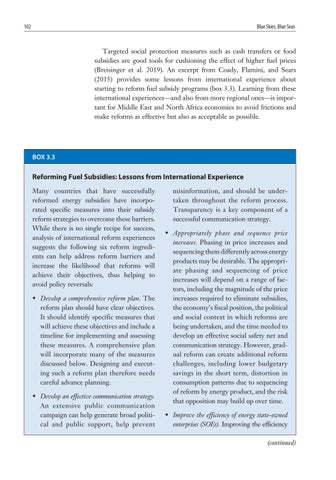102
Blue Skies, Blue Seas
Targeted social protection measures such as cash transfers or food subsidies are good tools for cushioning the effect of higher fuel prices (Breisinger et al. 2019). An excerpt from Coady, Flamini, and Sears (2015) provides some lessons from international experience about starting to reform fuel subsidy programs (box 3.3). Learning from these international experiences—and also from more regional ones—is important for Middle East and North Africa economies to avoid frictions and make reforms as effective but also as acceptable as possible.
BOX 3.3
Reforming Fuel Subsidies: Lessons from International Experience Many countries that have successfully reformed energy subsidies have incorporated specific measures into their subsidy reform strategies to overcome these barriers. While there is no single recipe for success, analysis of international reform experiences suggests the following six reform ingredients can help address reform barriers and increase the likelihood that reforms will achieve their objectives, thus helping to avoid policy reversals: • Develop a comprehensive reform plan. The reform plan should have clear objectives. It should identify specific measures that will achieve these objectives and include a timeline for implementing and assessing these measures. A comprehensive plan will incorporate many of the measures discussed below. Designing and executing such a reform plan therefore needs careful advance planning. • Develop an effective communication strategy. An extensive public communication campaign can help generate broad political and public support, help prevent
misinformation, and should be undertaken throughout the reform process. Transparency is a key component of a successful communication strategy. • Appropriately phase and sequence price increases. Phasing in price increases and sequencing them differently across energy products may be desirable. The appropriate phasing and sequencing of price increases will depend on a range of factors, including the magnitude of the price increases required to eliminate subsidies, the economy’s fiscal position, the political and social context in which reforms are being undertaken, and the time needed to develop an effective social safety net and communication strategy. However, gradual reform can create additional reform challenges, including lower budgetary savings in the short term, distortion in consumption patterns due to sequencing of reform by energy product, and the risk that opposition may build up over time. • Improve the efficiency of energy state-owned enterprises (SOEs). Improving the e fficiency (continued)






